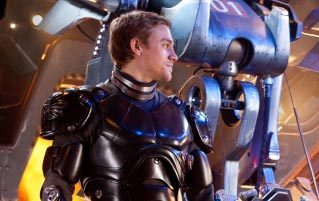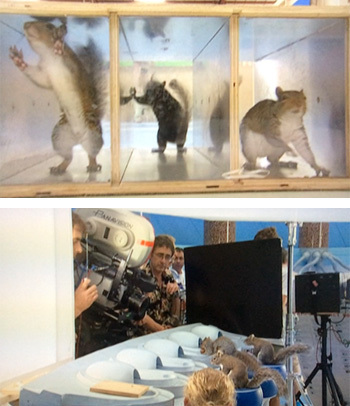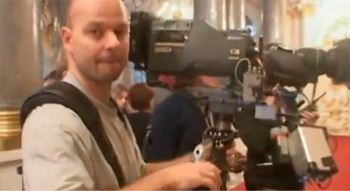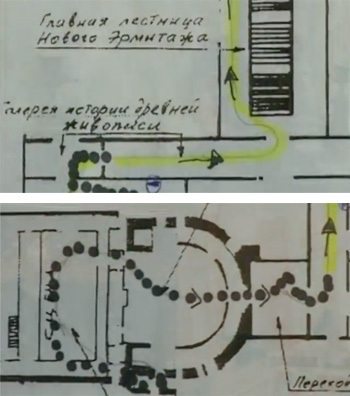6 Movies That Were Surprisingly Hard to Make

With all the advanced technology available to Hollywood today, it's easy to assume that they have a shortcut for everything. Today's lazy filmmakers can sit down at a MacBook and achieve the same kinds of effects that used to cost a million dollars and a couple of exploded BMWs. But it turns out that Hollywood magic isn't dead, and many of the scenes that had you screaming "Fake!" at the screen took way, way more effort than you realized ...
Pacific Rim Built Fully Functioning Giant Robot Heads

Pacific Rim was director Guillermo del Toro's love song to Japanese monster movies, and if you're making a movie about giant robots punching monsters, you pretty much expect to be doing it all in front of a green screen. That's what the actors thought, anyway, until they turned up at the studio and saw this:

That's the "Conn-pod" rig. And yes, it's a four-story re-creation of a giant robot head that has been mechanically designed to mimic the effects of being inside said robot as it wrestles with huge monsters. Kind of like the anti-George Lucas, del Toro wanted his big, goofy robot extravaganza to rely as little upon digital effects as possible.
So rather than simulate actors getting thrown around like rag dolls, he actually had them whip around a big metallic body sling while hosing them down with gallons of water, which was more than a little risky, considering that they were surrounded with real electrical devices.


If that seems unnerving, it gets worse -- along with being on some kind of waterboarding fun house ride, the actors had to be built into the rig and physically controlled by puppeteers. That meant they not only could feel the terrifying sensation of metal rods turning them into a living Pinocchio, but knew that something as simple as taking a leak required an hour of laborious disconnections.

Charlie and the Chocolate Factory Trained Actual Squirrels

While most of us vaguely remember Tim Burton's Willy Wonka remake as nothing more than a cinematic fart, that doesn't mean the people behind the scenes didn't put a crapload of tedious work into making it. For example, there's a scene that you've probably long forgotten in which Wonka Depp reveals that he's trained a bunch of squirrels to put nuts on a conveyor belt. You might think this was the work of a bunch of people in a CGI sweatshop rendering it on workstations, but those were real squirrels, and training them to do this took months.

In other words, while it's easy to believe that Willy Wonka would be crazy enough to try to train real squirrels to do his work, the only person crazier than Willy Wonka is Tim Burton, who actually did it.

There were some CGI shots thrown in (if you watch the scene, it gets pretty silly toward the end), but for the most part those are real squirrels doing real tricks -- and no, squirrels are absolutely not really animals you can train (if you want to see what we mean, go out right now and try to catch one). They don't have the generations of domestication that make it easy for you to teach your dog how to shake after a couple of weeks of practice. This horde of rescue squirrels needed several months of careful, incredibly frustrating training just to master the task of cracking and discarding nuts.

The process not only took thousands of training repetitions per animal, but also required specially made metal nut props (any material of lesser strength got chewed to crap).

Eventually, the script called for the squirrels to brutally attack a young girl, because that's just what happens when you get Tim Burton to helm a Roald Dahl movie. And they trained them to do that as well:

Rather than put a real child actress at the mercy of a dozen razor-clawed and frustrated rodents, they used a stunt double wearing the actress's face as a mask, which served as a way to make her look like the girl, as well as to protect her from having her eyes clawed out.

Iron Man 3's Skydive Rescue Was Done With Real Skydivers

Iron Man 3 predictably made use of a lot of digital effects to portray a man in a rocket suit fighting soldiers made of lava, so you probably assumed that the biggest action scene -- in which Iron Man has to save a bunch of people after they get sucked out of a plane -- was also CGI, if only because you can't just throw a bunch of actors out of a plane without parachutes (they have union rules against that kind of thing).
According to executive producer Louis D'Esposito, the original plan was to do it in front of a green screen, until a second unit director mentioned that he happened to know the Red Bull Skydiving Team, somehow. So they decided to go ahead and do it live with a bunch of adrenaline junkies hopped up on energy drinks.

Of course, the problem with shooting this scene for real was that even professional skydivers prefer to have parachutes when they jump out of an aircraft. Grudgingly acknowledging this, the film crew rigged up special costumes that would hide parachutes underneath their clothing. Then they spent a week with 8 jumps a day practicing the scene, which to the people down below must have looked like the government was just throwing hundreds of people in business suits and military uniforms out of a plane for some reason.

Along with proving that skydiving is way harder to learn than acting, the team also had to double as Iron Man himself, as well as operate the camera. That means the entire action sequence of a multimillion-dollar blockbuster hinged on a group of people sponsored by a drink that makes urine look like Tang.

By the time they got to the water-landing sequence, it's almost disappointing to learn that they zip-lined 14 actors down a 160-foot-tall crane into an actual body of water like some kind of demented homemade Six Flags ride.

Evan Almighty Built an Actual Ark

Aside from a new summerhouse for Morgan Freeman, no one was expecting much out of the sequel to Bruce Almighty that nobody asked for. So you'd be forgiven for believing that Evan Almighty was such a cynical cash grab that nobody would give enough craps to, we dunno, build a perfect re-creation of Noah's Ark from the ground up.

Designed by Linda DeScenna, a production designer who worked on Blade Runner and Back to the Future Part II, the wooden monstrosity was constructed to be 250 feet long, 80 feet wide, and 50 feet high, in the middle of a Virginia housing development. Because screw models.

And when the crew wasn't basking in its glory, they were shooting on a separate 90-foot-long indoor version of the ark, along with 200 live animals of 90 species ranging from lions to otters to horses, all being handled by 86 trainers.

With all those animals running around, care had to be taken to make sure that all the ones that would have liked to eat each other weren't left in the same room together. The lion needed four trainers alone. Of course, the original Noah managed the same feat with just his family, so props to him, we guess.
For a film with tons of CGI arks and animals, it's almost as if they did it all just to see how much money it would take -- especially when you consider that the ark set was disassembled within a week after the shoot ended, like some kind of "get in, get out" covert biblical spy mission.
The Evil Dead Remake Tried to Kill Its Actors

When the 2013 Evil Dead remake was announced, fans gave a sigh of nerd relief upon learning the director's plan to exclude any CGI in hopes of preserving the spirit of the 1981 version. While that obviously involved a cool handful of prosthetic and makeup effects, most of us probably didn't think he was also talking about the sinister torture that was inflicted on the original production's cast and crew.
For example, when you're making a CGI-free movie that includes a scene in which someone vomits blood on another person's face for a full half-minute, there's unfortunately only one real way to do it: waterboarding the actress.

That's what Jane Levy was made to do to co-star Jessica Lucas, who just had to lie back and think of her bad decisions while taking a fire hose blast of slimy red goop. Their understanding was that she would pinch Levy when she began to suffocate.
Levy called being on the giving end of the act the least favorite thing she's done in her life -- which is saying a lot considering everything else they made her do in that movie, like when they covered her face in plastic and buried her alive.

No, really. While they easily could have put a dummy or something in the ground, that just wouldn't convey the realism the filmmakers were going for, so they fitted Levy with an oxygen tube ( that would occasionally stop working) and a plastic bag tied around her dome, and then they covered her with dirt. Because it's not a really realistic horror movie if you're not actively trying to murder your cast.
The Film Russian Ark Was Done in a Single Grueling Shot

Steering away from big-budget blockbusters about exploding robots and iron men, Russian Ark is a 2002 Russian art house film in which the characters mostly walk around quietly discussing paintings. But what sets this movie apart is that the entire thing is one 86-minute-long unbroken shot. That means that every time an actor fumbled a line or the boom mic slipped into the shot, they had to stop the camera, put every single cast member back to their starting positions, and start filming again from minute one.
If that doesn't sound challenging enough, the thing was filmed in a real museum that they were only allowed to shut down for a couple of days. The next time you hear someone in Hollywood complain about a filming schedule that only gives them a few months, imagine being told you have 36 hours to build your set, assemble your actors, and shoot your movie from beginning to end. Oh, and when we say "actors," we're talking about the full cast of around 1,860 people.

To elaborate: In the span of 36 hours, the production team had to remove all the museum items and truck in equipment:

Build and light portable sets in 36 separate rooms:

Bus in the nearly 2,000 actors and extras dressed in authentic clothing by 65 costume designers and 50 makeup artists:

And get a Steadicam operator to wear 77 pounds of camera:

And then they just went for it -- shooting a film that involved dancing scenes, an orchestral performance, horses, and a final sequence involving 300 extras. As you can imagine, it took a bit of planning.

Then there was the fact that they had to shoot both indoors and outdoors at -24 degrees, which meant that at any point during the temperature transition the camera lens could have fogged up and ruined the entire movie right then and there.
It took four takes to get it right. By the time the camera started rolling for the fourth time, the light was fading, the batteries were almost dead, and it would have taken only one more screw-up to sink the entire project. The whole thing was so unnerving that by the end the director looked somewhere between a new father and a flood victim.

And that wasn't even the guy holding the camera -- who almost gave up near the end of the film after the weight of the ordeal started causing him groin pain. Luckily he kept going, and we wound up with a cinematic achievement that most Western audiences will never know exists. It's on Netflix -- go give it a watch, just to see what can be accomplished in a few days when a group of artists are ambitious (and crazy) enough to see it through.
Want to know more interesting tidbits about famous movies? Check out 30 Mind-Blowing (True) Facts about Famous Movie Scenes and 36 Plot Holes You Never Noticed in Famous Movie Scenes.
Related Reading: If you're a fan of easter eggs, click here. You'll learn about how each character in The Departed was marked for death. And did you know they painted the whole set sepia for The Wizard of Oz? If you're interested in the insane messages you never noticed in famous films, click here.